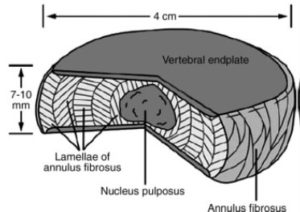If you suffer from back pain, you are not alone. In fact, most of the adult population in the United States suffers from back pain in some form or another at some point in their lives. Some causes of back pain are clear: trauma from a motor vehicle collision, a fall, or a direct blow to the spine, for example. What is not as clear is the source of back pain for the rest of the population. It is estimated that 85% of the people in the United States who suffer from chronic back pain cannot trace it to an exact biological cause.[1] The costs of treatment for patients who suffer from back pain in the United States is estimated to be between $30-$50 billion per year.[2]

A recent study review has sought to summarize decades of research on what may be the likely source of back pain for most people: changes in innervation to the intervertebral disc (IVD).[3] The IVD is composed of three different structures: the nucleus pulposus, the annulus fibrosis and the vertebral endplates. The nucleus pulposus is made up of proteoglycans and water and acts as a shock absorber for the spine. The annulus fibrosis is the outer structure of the disc that stabilizes and dissipates the forces that occur on the disc. The vertebral endplates serve to anchor the disc to the bone and are composed of two regions: a hyaline cartilage region and a porous bone region that connects the disc directly to the bone.
The scoping review study analyzed 33 articles on the IVD published between 1940 and 2019 and the majority of these studies (16/33) were focused on pain generators to the lumbosacral spine. The study came up with an interesting synthesis on several points:
- The annulus fibrosis is the most innervated tissue of the IVD with neural elements generally localized to the outer one third of the annular fibrosis; neural elements were found in the inner two thirds of the annular fibrosis with IVDs with a history of back pain, degeneration, or related spinal pathologies.
- Nerve fibers without adjacent blood vessels were found throughout the outer and inner annulus fibrosus in the majority of studies (30/33).
- Mechanoreceptors were highlighted in eight studies and were classified as proprioceptive, low or high frequency vibration or pressure and were found in both control and painful IVDs.
- In 23/33 of the studies, no neural elements were reported in the nucleous pulposus of control IVD tissues, suggesting it is a largely aneural structure. However, in the remaining studies that did report neural elements within the nucleus pulposus, the IVDs in those studies were degenerative and/or from patients reporting back pain.
- Only 5 of the 33 studies had any data on neural elements within the vertebral endplate, but these few studies consistently found perivascular nerve fibers and never fibers not associated with blood vessels and similar to other parts of the IVD, there were increased nerve fibers in degenerative IVDs when compared to controls. Additionally, nerves were present in 90% of endplate defects.
- While age was not included as a variable in any of the studies (due to mechanical factors, genetics, other physiologic changes), it was generally recognized that the IVD becomes more innervated with age-related degeneration or spine-related pathologies.
Given the prevalence of discogenic back pain in the U.S., we often deal with the issue of acute back and neck pain due to trauma superimposed on chronic neck and back pain. The attorneys at Adler Giersch are very familiar with this issue and how it can affect your patients, their treatment, and access to care when dealing with insurance companies and we are always available to help you and your patients with any questions that come up. Please don’t hesitate to contact us.
[1] Deyo RA, Weinstein JN. Low back pain. N Engl J Med 2001; 344(5):363–70;Deyo RA, Mirza SK, Martin BI. Back pain prevalence and visit rates: Estimates from U.S. national surveys, 2002. Spine (Phila Pa 1976) 2006;31(23):2724–7.
[2] Chou R, Shekelle P. Will this patient develop persistent disabling low back pain? JAMA 2010;303(13):1295–302.
[3] Groh AMR, Fournier DE, Battié MC, Séguin CA. Innervation of the Human Intervertebral Disc: A Scoping Review. Pain Med. 2021 Jun 4;22(6):1281-1304. doi: 10.1093/pm/pnab070. PMID: 33595648; PMCID: PMC8185559.
